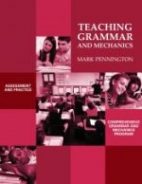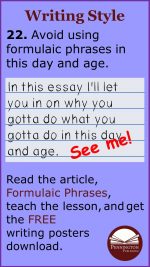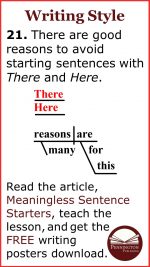
Pennington Publishing Writing Programs Integrated Writing and Grammar.
Since the burden (and privilege) of teaching writing falls so exclusively on the teacher or workplace supervisor, it makes sense to learn what works from the research on writing feedback. Let’s take a look at the decades of research and add some practical tips based upon those research implications to help you improve your writing feedback skill-set. Also, at the end of the article, I’ll share an approach to writing feedback that will alleviate some weight from that burden. Yes, you can save time grading or editing stories, essays, and reports, while improving the quality of your writing feedback.
Let’s get on the page about what we mean by writing feedback. Feedback is a form of response focused on helping someone meet a goal. It is communication which helps someone understand something more fully or practice more effectively.
What Kind of Feedback is Effective?
1. Specific, Not General
According to Hattie and Timperley, “Feedback is often lost on students because it’s too vague. Comments like “great job,” “good writing,” or even “needs better organization” fall flat with students because they’re not tied to specific words, phrases, sentences, or paragraphs in writing.”
and
“…studies which demonstrated the most impact on student learning involved students receiving information about a task and how to do it more effectively. Much lower impacts were related to praise, rewards, and punishment–forms of response that don’t have the characteristics and focus of feedback.”
Use focused, not unfocused feedback. “Focused corrective feedback was more useful and effective than unfocused corrective feedback” (Sheen, Wright, and Moldawa 2009).
2. Immediate, Not Postponed
Writing feedback is most effective when students “have an immediate opportunity to try out the suggestions in their writing, allowing for meaningful application of what they have learned from the feedback. Focusing on individual students’ immediate writing needs, this ongoing feedback is a form of differentiated instruction that complements the teaching of mini-lessons to small groups or to the whole class” (Peterson, S.S. 2008).
When writing feedback is postponed, little is acquired, retained, and transferred to the next writing assignment. Accordingly, summative feedback is of little value. Relying solely upon rubric scoring for writing feedback produces no statistically significant correlation with improved writing skills.
3. Routine Revision
Writing instruction “routinely engaging in revision is associated with better writing performance. Students who were required to routinely revise scored highest on the National Association of Educational Progress. Those who were never asked to revise scored poorly.
The power of feedback is its value in facilitating revision, such as revising an essay or revising one’s understanding of a concept. Revision is one of the key differences between expert and inexpert writers. Expert writers revise. Beginning and inexpert writers don’t revise much. Or at all” (Jeff Grabel Michigan State University).
4. Formative, Not Summative
Good writing instruction often requires students to complete multiple drafts. Writing feedback research has universally concluded that writing guidance on initial drafts is superior to comments upon final drafts, in terms of facilitating writing improvement. Comments on drafts of writing provide students with timely information about the clarity and impact of their writing. When students receive feedback while they are writing, “they are more inclined to use it to revise and edit their drafts than they would be if they received the suggestions on a graded, polished copy” (Nicol, D.J., & Macfarlane-Dick, D. 2006).
Simply put, revision is how students learn how to write–not the 1–5 scores on an ending holistic rubric.
5. The Earlier the Better
“Give feedback on the content, organization and style features of the writing in early drafts. If students focus on writing conventions early in the writing process, their flow of ideas may be curtailed. – In addition, students may edit sentences that will later be cut during revisions. Give feedback on adherence to writing conventions when the writing is almost complete” (Peterson, S.S. 2008).
Teachers should not accept sloppy copies. Students must be taught how to use grammar and spell check (Google Docs has a brand new tool which identifies issues and suggests revisions). Students need to share their best efforts at each stage of the writing process. Establishing high expectations and writing standards improves student performance and lightens the editing load of teachers. Teachers should spend writing feedback time on writing advice, not editing.
6. Error Explanation
Simply circling errors or using diacritical marks produces ineffective revision. Writers do not know what they don’t know. Simply writing FRAG does not explain why the sentence is incomplete or how to fix it. Other than typos, writers rarely make mistakes when they know better. When errors are simply marked without explanation, students will continue to make the same mistakes over and over again.
A focus on error analysis is essential. “Students who receive feedback on their written errors will be more likely to self-correct them during revision than those who receive no feedback—and this demonstrated uptake may be a necessary step in developing longer term linguistic competence.
Students are likely to attend to and appreciate feedback on their errors, and this may motivate them both to make corrections and to work harder on improving their writing. The lack of such feedback may lead to anxiety or resentment, which could decrease motivation and lower confidence in their teachers” (Ferris, D. R. 2004).
7. The Right Amount
Too many comments can overwhelm and dishearten developing writers. Instead of marking and explaining every writing error, Peterson suggests “… identifying patterns of convention errors, rather than every error in the paper. Students are more likely to learn how to use a convention correctly if they attend exclusively to that type of error when editing their writing” (2008).
8. The Right Ones
Not all writing issues are created equal. Clearly, some are more important to focus upon than others. Maxine Hairston (1981) suggests that certain errors are perceived as higher status than others. This researcher found that these errors were seen to be more egregious by most teachers: nonstandard verb forms, lack of subject-verb agreement, double negatives, objective pronoun as subject. Other errors are perceived as low status and may not warrant marking: unnecessary or inaccurate modifiers, use of a singular verb with data, use of a colon after a linking verb” (https://teaching.berkeley.edu/sites/default/files/not_all_errors_are_created_equal.pdf)
Additionally, it makes sense to focus upon teachable writing issues. Writing issues which are generalizable have great need for writing feedback than once in a blue moon issues.
Plus, subject-verb agreement issues can be remedied (despite exceptions, there are rules); however, writing tone and style are tougher to teacher. Hence, provide writing feedback that will get the greatest bang for the buck.
Teachers tend to mark errors and comment on content or process. Instead, writing researchers suggest that teachers should comment on both. Choosing to concentrate on errors that can be easily explained to the student with the greater likelihood of producing positive transfer to subsequent writing assignments just makes sense. For example, errors in speaker tag commas can be easily remediated because the rules are relatively unambiguous; errors in commas isolating dependent clauses are harder to remediate because the rules are more ambiguous and context dependent.
9. Variety of Communication Modes
The same format of writing feedback can bore students and diminish attention to what has been said. In an interesting study regarding using audio comments with a control group of written comments, Dr. Martha Marie Bless found a statistically significant difference in the amount and quality of student revisions and skill acquisition in favor of the audio comments (Walden University 2017).
10. Accountability
All too often, students glance at writing feedback and do little or nothing to revise or learn from teacher comments. Teachers who incentivize writing revision with points, praise, privileges, etc. tend to get better results.
Technology helps hold students accountable for their revisions. Microsoft Word® provides Track Changes and Google Docs offers Revision History to check whether or not students have worked to improve writing from draft to draft. Using different color font or pens, writing, achieves the same end.
Sources Cited
- The Power of Feedback by John Hattie and Helen Timperley, in Review of Educational Research 77 (March 2007): 81-112.
- Seven Keys to Effective Feedback by Grant Wiggins in Educational Leadership 70.1 (September 2012): 10-16.
- Revision Strategies of Student Writers and Experienced Adult Writers by Nancy Sommers in College Composition and Communication 31.4 (December 1980): 378-388.
- Training Advanced Writing Skills: The Case for Deliberate Practice by Ronald T. Kellogg and Alison P. Whiteford in Educational Psychologist 44.9 (2009).
- The effects of word processing on the revision strategies of freshmen by Gail Hawisher in Research in the Teaching of English 21 (May 1987): 145-159.
- A Multimodal Task-Based Framework for Composing by Jody Shipka in College Composition and Communication 57.2 (December 2005): 277-306.
- Opening Minds: Using Language to Change Lives by Peter Johnston, Stenhouse Publishers (2012)
- National Assessment of Educational Progress (NAEP) 2007 writing report card Findings from the National Assessment of Educational Progress. Washington, DC: U.S. Department of Education, Institute of Education Sciences, National Center for Education Statistics
*****
To improve writing feedback and integrate writing and grammar in step-by-step programs, check out Pennington Publishing. View entire programs and test-drive our free resources.
Grammar/Mechanics
canned comments, diacritical marks, e-comments, editing marks, insertable comments, Mark Pennington, Teaching Essay Strategies, Teaching Grammar and Mechanics, writing feedback, writing feedback research

![]()








